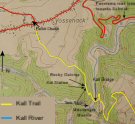Medical Support and Evacuation for the
112th Infantry Regiment, 28th Infantry Division,
in the Battle for Schmidt

The attack of the 28th Infantry Division on the town of Schmidt in the Hürtgen Forest in early November 1944 occupies a special place in the history of the U.S. Army’s operations against Nazi Germany in World War II. Fought under awful weather conditions over very difficult and heavily-forested terrain along the Kall River on the German-Belgian border south of Aachen, Germany, the Battle of Schmidt was one of the bloodiest and most wasteful American operations of the war in Europe. The 109th, 110th, and 112th Infantry Regiments of the 28th Infantry Division and attached units were all engaged in these operations. However, the 112th Infantry bore the brunt of the fighting and casualties in the towns of Vossenack, Kommerscheidt, and Schmidt and along the Kall River Trail that connected Vossenack with Kommerscheidt and Schmidt to the east of the Kall River.
Within days, medical personnel of the 112th Infantry completed these reports which provide a graphic picture of the challenges that regimental and battalion medical personnel faced in caring for and evacuating the wounded and sick soldiers under such appalling conditions. Capts. John S. Howe and William J. Fox, 2d Information and Historical Service, European Theater of Operations, subsequently interviewed many members of the 28th Infantry Division who had participated in these operations. They did not, however, apparently interview any of the medical personnel. They did collect a number of reports that medical personnel had already submitted to the 112th Regimental Surgeon and division surgeon. These documents are part of the larger collection of 28th Infantry Division interviews and draft historical reports that were compiled by the 2d Information and Historical Service for use of the ETO historian’s office. These documents were later used in writing the official history of the U.S. Army in World War II, specifically in Charles B. MacDonald’s, The Siegfried Line Campaign, and his chapter on Schmidt in Three Battles: Arnaville, Altuzzo, and Schmidt. Now entitled Combat Interviews 75 and 76, 28th Infantry Division in the Hürtgen Forest, today these documents reside in the Record Group 407, Box 24032, National Archives and Records Administration, at College Park, MD.
| Report on Medical Evacuation
Maj. Albert L. Berndt, Medical Corps, Surgeon, 112th Infantry Regiment |
| Evacuation of Wounded
from Vossenack Kommerscheidt and Schmidt Areas
Capt. Paschal Linguiti, Medical Corps, Surgeon, 1st
Battalion, 112th Inf Reg, and Capt. Michael DeMarco, Medical
Corps, Surgeon, 3d Battalion, 112th Inf Reg. |
| Misuse of Aid Station
Site
Capt. Paschal Linguiti, Medical Corps, Surgeon,
1st Battalion, 112th Infantry Regiment |
| Report on Medical Evacuation
2d Lt. Alfred W. Muglia, Medical Administrative Corps,
Assistant Battalion Surgeon, 3d Battalion, 112th Infantry
Regiment |
| Report of Medical Evacuation
2d Lt. Henry W. Morrison, Medical Administrative Corps,
Medical Detachment, 112th Infantry Regiment |
| Casualty Evacuation Report
1st Lt. Loyd C. Johnson, Medical Administrative Corps,
Company C, 103d Medical Battalion, 28th Infantry Division
n.d. |
| Battle Casualties - Vossenack-Kommerscheidt-Schmidt
Capt John S. Howe, Infantry, 2d Information and Historical
Services, n.d. |
Chief, Office of Medical History
Office of The Surgeon General, U.S. Army


